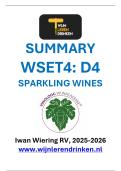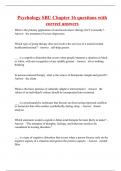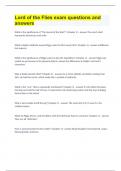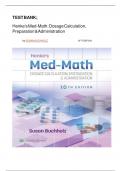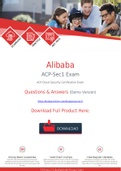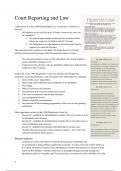WSET4: D4
SPARKLING WINES
Iwan Wiering RV, 2025-2026
www.wijnlerendrinken.nl
, Iwan Wiering RV, Summary WSET4 D4: Wine Production, 2025-2026
Summary WSET4
D4 Sparkling Wines
Iwan Wiering:
I am a Dutch wine teacher, music teacher and conductor. In 2020 I graduated WSET3. In 2021 I
aced all 4 exams (3 theory modules and 1 tasting module) at the Dutch Wine Academy in 1 day,
becoming “Registervinoloog van de Wijnacademie”. In 2023 I started studying for the WSET4
Diploma. I hope this summary will help you ace your D4 exam, as it helped myself to get
prepared for the exam.
In the last few years I gathered many digital maps. Please check www.wijnlerendrinken.nl for
more information on how to take advantage on them on a small cost.
Please use a licensed purchased copy of this summary only, since I put a lot of time and effort in
writing it. Diploma Course will cost you around Euro 10.000,00 at least. Please don’t economize
for the last few Euros, but let me be of a little profit instead. This way I can keep on writing many
documents and summaries to your advantage, and keep them updated.
As WSET stimulates ‘talking around the subject’ and ‘flair’ to gain higher marks, I added some
useful extra info from the ‘Champagne MOOC’ and several webinars in this summary, that
doesn’t show in the textbook but might help you to a higher percentage. I can advise you to take
the (free) course on Champagne MOOC (champagne-mooc.com)
Please also check some useful podcasts on https://eatsleepwinerepeat.co.uk/podcasts/ as
they can be very helpful.
Also check:
Wine Explorer - Introducing Champagne (youtube.com)
Champagne Rosé - maceration and blending techniques (youtube.com)
Discover Australian sparkling wines with Emma Symington MW (webinar) (youtube.com)
Italian sparkling wines - Prosecco and beyond (youtube.com)
Franciacorta in focus (youtube.com)
Discover Champagne with Lauren Denyer DipWSET (youtube.com)
Miami Champagne Week Day 1: Natural Champagne Webinar (youtube.com)
Miami Champagne Week Day 2: The Art of Perrier-Jouet (youtube.com)
Miami Champagne Week Day 3: Meunier Webinar with Matt Citriglia MS (youtube.com)
Miami Champagne Week Day 4: Blanc de blancs Webinar with Essi Avellan MW and Frederick
Panaiotis (youtube.com)
Miami Champagne Week Webinar (youtube.com)
Miami Champagne Week 2021 - Day 1 - Vintage Champagne with Essi Avellan MW
(youtube.com)
2
, Iwan Wiering RV, Summary WSET4 D4: Wine Production, 2025-2026
Categories and types of Cava | Sparkling Wine | D.O. Cava .
Seven Sparkling Wines To Revisit Just Before Your Exams — Elevage Wine Coaching | Private
Wine Coaching & Certification in the UK and the United States
Cheers and thanks, Iwan.
Compare:
To compare, you need to describe and explain about the similarities and differences between
the subjects of the questions. Connecting words or phrases such as "however, although, yet,
nevertheless, conversely" may help you to build your argument.
Assess/evaluate:
Judge the quality, importance or value of something. Consider the advantages and
disadvantages or strengths and weaknesses of something.
Describe:
To describe something, you will need to set out the characteristics of the subject. For example,
you may be asked to write a detailed description of a process. The higher the level of relevant
detail, such as correct temperatures, in the answer, the higher the grade achieved. It would
seem to be the case that if the command verb ‘describe’ appears in a question, you simply need
to recall the facts that you have learned. However, in many examiners’ reports that even when
the command verb is ‘describe’, they are STILL expecting you to make those crucial links
between the production factors and the style, quality and price of the grapes or wine. They are
looking for both knowledge AND application of that knowledge. So make ‘LINKS’ even when the
verb is ‘describe’. Be sure to make enough ‘how’ and ‘why’ links.
3
, Iwan Wiering RV, Summary WSET4 D4: Wine Production, 2025-2026
For each sparkling wine method, make sure you can answer the same 5 questions.
1. HOW is it done? (describe the vinification step by step)
2. WHEN is it done?
3. WHY is it done? (dis)advantages of this production method?
4. WHICH wines are produced this way?
5. WHERE are these wines produced?
Examples:
Tank method / Cuve close / Charmat process / autoclave
method / método Granvas / Martinotti method
HOW IS IT DONE?
In pressurised tank:
1. clarification and stabilization
2. Slow and cool 1st fermentation (in batches throughout the year)
3. yeast and often sugar are added to tank to initiate second fermentation
4. agitators or rotators➔ for increased yeast contact (optional)
5. 2nd fermentation/ yeast contact 10–120 days
6. wine is cooled after fermentation (-5°C)
7. Yeast is removed by centrifugation or filtration
8. SO₂ and dosage is added and chilled wine (-2°C) is bottled
Cheaper, faster and not so labour intensive compared to the traditional method.
WHEN IS IT DONE?
Directly after first fermentation.
Suitable for wines from aromatic varieties or for those wines with little capacity for ageing
WHY IS IT DONE?
Aroma/ flavour: no (or hardly any) autolytic impression.
Primary aromas and flavours are often desired.
Aroma/ flavour: can be easily adapted to new trends.
Economies of scale, consistency. Made often from mediocre base wine.
Little (or none) ageing capability is needed.
WHICH WINES ARE PRODUCED THIS WAY?
Lambrusco, Asti, German Sekt, French Mousseux, Prosecco, PetNat…
WHERE are these wines produced?
Italy, Germany, France….
4
, Iwan Wiering RV, Summary WSET4 D4: Wine Production, 2025-2026
Asti method (a variation on the tank method)
HOW AND WHEN IS IT DONE?
1. Must of Muscat blanc à petit grains stored at 0°C to retain freshness up to 12 months.
2. Must fermented at 18-20°C until 5% abv and then again chilled to about 0°C (no CO₂ retained
at this point).
3. When wine is ready for sale, fermentation is restarted until 7-9½ % abv is formed. CO₂
retained, as is residual sugar. Total length of fermentation about 10 days.
4. Filtered (to avoid re-fermentation) and bottled under pressure.
Moscato d’ Asti: lightly sparkling, 1-2½ bar, 5% abv.; less producers; 30 million bottles.
DOCG Asti (spumante) (since 1994): stronger; 6+% abv. 3 ½ -4 atmosphere; less residual
sugar; 50 million bottles.
WHY IS IT DONE?
To retain fruitiness
WHICH WINES ARE PRODUCED THIS WAY?
Asti and Moscato d’Asti
WHERE ARE THESE WINES PRODUCED?
Asti in Piemonte.
I give the grape varieties a double number: 1 = early, 2 = mid, 3 = late.
First number for budding, second number for ripening.
Example: 11 = early budding and early ripening.
5
, Iwan Wiering RV, Summary WSET4 D4: Wine Production, 2025-2026
1: Standard Options in Sparkling
Winemaking
Learning Objectives:
• Describe the Traditional Method production process.
• Explain how winemaking and post-fermentation options impact on the style, quality and price of
traditional method sparkling wines.
• Explain how natural factors and grape growing impact on the style, quality and price of traditional
method sparkling wines.
• Explain how wine making and post fermentation options impact of the style, quality and price of
traditional method sparkling wines.
• Compare different styles and quality of traditional method sparkling wines.
• Describe the Tank Method process.
• Explain how wine making and post fermentation options impact of the style, quality and price of
Tank Method sparkling wines.
• Describe the Pet Nat Method.
1.1. The Growing Environment
Yields significantly higher than still wines.
Best-exposed sites: still wines (more ripeness).
Less well-exposed sites: sparkling (maintaining acidity).
Hills: less fertile, better drainage, cooling influences altitude and higher diurnal range: longer,
slower ripening, maintaining acidity.
Limestone: good drainage and water retention.
Clay and silt (Lambrusco): High water holding capacity and fertility. Can be too cold, prone to
compaction and lacks drainage. Wine: lower acidity and more pronounced fruit.
Chalk (Champagne, England): Good drainage (highly porous) and water retention (like a
sponge): steady supply of water even in dry periods. Lower fertility. However, chalk soils tend to
be on slopes at higher elevations: more vulnerable to adverse weather. Wine: more finesse,
higher acidity, leaner body.
Ideal: cool climates where grapes struggle to ripen and picked early:
• grapes just-ripe (but not under-ripe) in flavour (apple, lemon: delicate flavours so that
autolytic flavours are not overwhelmed), but retain high acidity required for high-quality
sparkling, needed to withstand the lengthy ageing process in bottle and required for
balance final wine.
• Sugar accumulates slowly: still base wine low alcohol (9–11% abv), necessary because
2nd fermentation produces additional 1–2% abv.
Better achieved by high yields (output vineyard maximized) and some assurance in lower-
yielding years. Picked early to avoid autumn rain and damage to fruit from fungal disease; this
will maintain acidity, but shortens ripening period (chance of unripe flavours).
Grapes therefore grown:
• greater latitudes (Champagne, England, Tasmania)
• local cooling influences: near cool coast (Sonoma, Chili) or high altitude (Trentodoc,
Argentina).
Climate change: earlier harvest, lower acidity, higher potential alcohol. Cool regions: better
conditions to produce more consistently ripe grapes and fewer poor vintages. However, also
6
, Iwan Wiering RV, Summary WSET4 D4: Wine Production, 2025-2026
risk more extreme weather, like heavy rain. In addition, increased risk frost damage because
earlier budding due to warmer springs. However, biggest threat to yields is prolonged rain.
Maritime climate:
• rain and cool temperatures flowering and fruit set: reduce yields.
• rain during harvest threat to quality: spread of fungal disease and dilution crop.
Priorities: managing vineyard (spraying against fungal diseases), canopy management and
managing financial risks of fluctuations yields and quality.
Warmer areas: riper fruit flavours, lower acidity. Desirable for short-aged wines (tank, short on
lees transfer/traditional): dominant fruity flavours. However, for elegant, balanced, long-lees-
aged sparklings less intense fruit flavours preferable. Cheaper sparklings grown in cheaper,
easier to cultivate flat, fertile plains (e.g. Prosecco DOC). Sometimes, grapes grown in places
unsuitable for still wines (would not achieve concentration/ripeness needed for good-quality
still wines).
1.2. Grape Growing
GRAPE VARIETIES
Champagne Pinot Noir (38%), Meunier (32%), Chardonnay (30% but increases)
Alsace Pinot Blanc Rosé: only Pinot Noir
Bourgogne Chardonnay, Pinot Noir Rosé: mainly Pinot Noir
Loire Chenin Blanc
Cava Macabeo, Xarello, Parellada, Chardonnay Rosado: Trepat, Pinot Noir
Prosecco Glera Rosé: 10-15% Pinot Noir
Asti Moscato Bianco
Lambrusco Lambrusco Salamino / Grasparossa / di Sorbara
Franciacorta Chardonnay (75%), Pinot Noir, Pinot Blanc
Trentodoc Chardonnay, Pinot Noir
Germany Winzersekt: Riesling. Klassische Flaschengärung also Pinot Noir, Chardonnay
England, Wales Pinot Noir, Chardonnay (+ some Meunier)
USA Pinot Noir, Chardonnay (Washington also Meunier)
Chile Chardonnay, Pinot Noir, Sauvignon Blanc
Argentina Chardonnay, Pinot Noir
South Africa Chardonnay, Pinot Noir, Chenin Blanc, Pinotage
Australia Tasmania: Chardonnay, Pinot Noir
New Zealand Chardonnay, Pinot Noir
All 3: neutral varieties, early budding, early ripening, sensitive to botrytis.
Chardonnay (11) Pinot Noir (11) Meunier (Pinot Meunier) (11)
Early budding (prone to spring frosts) and early ripening (suited to cool Early budding, but later than PN and Chard: less
climate): high acidity, low sugar while avoiding under-ripe flavours. prone to spring frosts cool Vallée de la Marne. Ripens
Chardonnay and Pinot Noir can flower poorly in wet and cool weather. earlier than PN and Chard: helpful in seasons where
harvest is interrupted by rain, and in cooler vintages
when PN might struggle to fully ripen. Also does well
on heavier soils (more clay) where the other varieties
would not succeed.
Prone to coulure and millerandage. Prone to coulure. Historically grown furthest from Reims and Épernay,
transported at bumpy roads by horse and buggy:
arrival winery in bad conditions.
Exposed chalk, like Côte des Blancs, Clay-limestone soils on deep Heavy clay, like Vallée de la Marne, where other
Côte de Sézanne and Vitryats. chalk, like Montagne de varieties might struggle to ripen in this cool climate.
Reims, Aube. Requires well-
drained soils.
More disease resistance than PN, but Thin skin, tight bunches and Particularly sensitive to botrytis. Better resistant than
susceptible to powdery mildew, more disease prone (downy PN.
grapevine yellows and to botrytis in wet mildew especially, powdery
periods before harvest. mildew, botrytis, fan leaf, leaf
roll).
7
, Iwan Wiering RV, Summary WSET4 D4: Wine Production, 2025-2026
Best years: high yields without loss of Yields more moderate than Mutation of Pinot, white hairs underside leaves give
quality: attractive for growers. Chard and quality drops if ‘floury’ appearance (meunier: miller). Can produce
yield is too high. high yields, but needs to be limited in young vines.
Subtle apple, citrus, floral, high acidity Body and structure, red fruit Light and fruity (yellow fruit), softness, roundness.
(delicate, elegant freshness, finesse): and flowers (rose, violets). Particularly important for NV (often aged on lees
complement rather than compete with Larger bubbles. shorter than vintage and drunk on release rather than
aromas yeast autolysis. Well suited for being cellared and bottle aged). Tends not to be used
autolytic styles (brioche, creamy, in wines intended for long ageing, though used at Krug
biscuit, graham cracker). Nutty after and among growers (e.g. Egly-Ouriet).
ageing. Small bubbles.
Why are Pinot Noir and Chardonnay popular grapes for premium traditional method sparkling:
• Cool climates where grapes struggle to ripen ideal for traditional method, as acidity in
the grapes needs to be high and sugar (potential alcohol) low to produce a still base
wine with low alcohol (9-11% abv), because 2nd fermentation produces an additional 1-
2% abv.
• Both are early budding and early ripening, making them well-suited to a cool climate
(however early budding makes them prone to spring frosts).
• Early ripening of Chardonnay and Pinot Noir is an asset in cool conditions. They also
retain the high levels of acidity and low levels of alcohol needed in sparkling wines while
avoiding under-ripe flavours.
• Both are non-aromatic grapes, so flavours complement rather than compete with
aromas from yeast autolysis.
• Both have a good ability to retain acidity and thus ability to age, which is important for
traditional method to withstand the long 2nd fermentation in the bottle.
• Both have good affinity to autolysis.
• Examples of wine regions using both varieties: Champagne, Trentodoc, Franciacorta,
England, Washington, Oregon, California, Tasmania, New Zealand.
• Chardonnay is capable of ripening in both cool and warm climates so can be used to
make premium traditional method wines in both cooler Old-World countries and also in
warmer regions such as in the New World (though there will usually be cooling
influences).
Factors grape variety that can influence style of wine:
• intensity of aromas (aromatic or neutral variety)
• ability to retain acidity while ripening
• how base wine responds to autolysis where applicable, e.g. Chardonnay becomes
creamy, whereas Xarel-lo becomes toasty and smoky.
VINEYARD MANAGEMENT
Range of training and trellising techniques depending on region, climate, varieties grown,
nutritional status soils. However, priority all areas to obtain clean, healthy fruit. Perception off-
flavours diseased fruit enhanced by effervescence. In addition, enzyme laccase (released by
botrytis-infected grapes) can cause serious oxidation.
HARVESTING
Both hand and machine, depending on location and local wine laws.
Hand harvesting Machine harvesting
Permits sorting at picking and post-harvest selection to Diseased or damaged grapes can be removed by hand just prior to
exclude disease-infected grapes. machine harvest, allowing a degree of selection, however, does
increase costs. Also permits night-time harvesting, delivering
cooler grapes (oxidation slowed down, resulting in fresher wines).
Hand picking and collecting in small crates minimise Can rupture skin of the grapes, resulting in phenolic extraction
splitting and crushing, and subsequent oxidation of this (including colour and tannin) and oxidation.
juice along with extraction of phenolics (colour and tannin).
8

